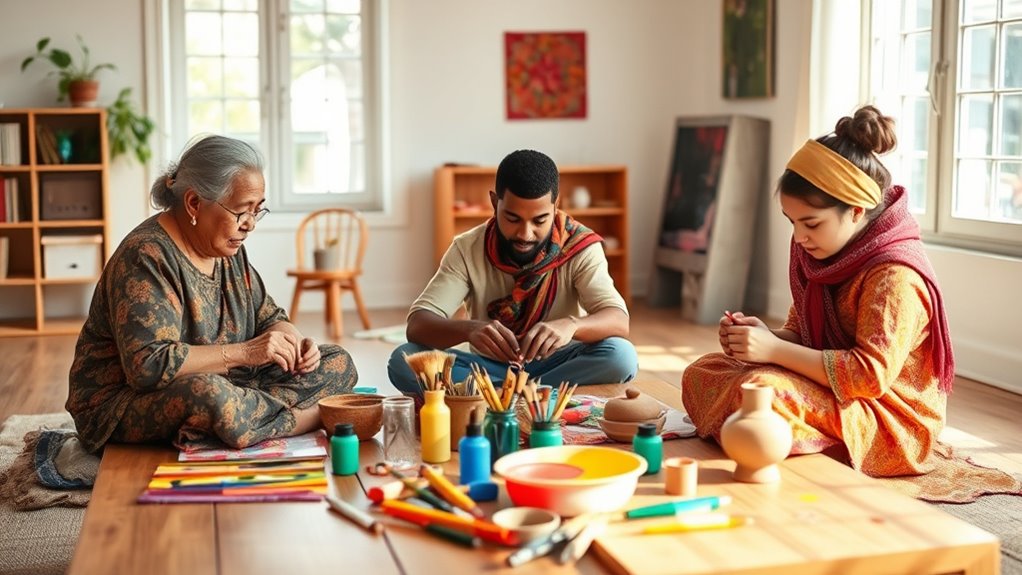Cross-cultural approaches to art therapy emphasize respecting and integrating clients’ cultural backgrounds to foster meaningful healing. You should understand that artistic symbols, colors, and styles can have different meanings based on each person’s culture. By using culturally relevant materials and listening carefully, you can create a safe environment where clients feel understood and valued. When you consider these cultural nuances, you’ll help clients express themselves authentically. Keep exploring to learn how to effectively incorporate these principles into your practice.
Key Takeaways
- Emphasize cultural sensitivity by respecting clients’ backgrounds and avoiding imposition of one’s own cultural perspective.
- Incorporate traditional art forms and culturally meaningful symbols to deepen engagement and self-expression.
- Interpret artwork within its cultural context, asking clients to explain the significance of symbols and motifs.
- Use culturally relevant materials and styles to foster identity affirmation and enhance therapeutic rapport.
- Recognize the variability of artistic expression across cultures to create a safe, inclusive environment for diverse clients.

Art therapy, as a powerful tool for healing and self-expression, takes on diverse forms across different cultures. When you explore art therapy in a cross-cultural context, you quickly realize that understanding and respecting cultural differences is essential. Cultural sensitivity isn’t just a courtesy; it’s the foundation for creating a safe, supportive environment where clients feel understood. You must recognize that artistic expression varies widely—what might be meaningful symbols or colors in one culture could hold different significance elsewhere. By being attentive to these nuances, you avoid imposing your own cultural lens and instead honor each individual’s unique background. This openness allows clients to express themselves authentically, using symbols, materials, and styles that resonate with their cultural identity.
Understanding and respecting cultural differences is essential for effective, authentic art therapy.
In practice, integrating cultural sensitivity involves more than just learning about different traditions. You actively listen and observe to understand how clients interpret their artwork within their cultural framework. For example, certain motifs or colors may carry specific spiritual or social meanings that you need to respect. You may also incorporate culturally relevant art forms or materials, like traditional textiles or indigenous art styles, to deepen the therapeutic process. Doing so not only affirms the client’s identity but also enriches the therapeutic experience by connecting it to their cultural roots. Additionally, understanding artistic expression in a cultural context helps you better interpret clients’ artwork and the stories behind their choices.
Artistic expression becomes a crucial bridge in cross-cultural art therapy, enabling clients to communicate complex emotions and experiences that words might not fully capture. You encourage clients to express themselves freely, embracing their cultural symbols and artistic traditions. This approach helps clients feel valued and understood, fostering trust and openness. As you facilitate their creative process, you remain mindful of cultural contexts, avoiding stereotypes or assumptions. Instead, you ask questions that invite clients to explain their artwork’s significance, demonstrating your respect for their cultural perspective.
Ultimately, embracing cultural sensitivity and honoring diverse artistic expressions enhances the effectiveness of art therapy across cultures. You create a space where clients can explore their identity, process trauma, or find healing through culturally meaningful art. It’s about more than just techniques; it’s about fostering an environment that respects and celebrates differences. By doing so, you help clients reconnect with their cultural roots, build resilience, and discover new pathways to well-being. Cross-cultural art therapy isn’t just about adapting methods; it’s about genuinely understanding and valuing the rich diversity each individual brings to the creative process.
Frequently Asked Questions
How Do Cultural Differences Influence Art Therapy Techniques?
Cultural differences influence your art therapy techniques by shaping how you interpret and incorporate cultural symbolism and artistic expression. You adapt your methods to respect clients’ unique backgrounds, using symbols meaningful to them and encouraging expressions that resonate culturally. This approach helps clients feel understood and safe, fostering deeper self-exploration. By tailoring techniques, you ensure therapy is culturally sensitive, empowering clients to communicate authentically through their art.
What Are Common Challenges in Cross-Cultural Art Therapy?
Steering cross-cultural art therapy is like steering a ship through fog—you must constantly adjust to unseen currents. You face challenges like cultural stereotypes, which can cloud your understanding, and maintaining artistic authenticity, ensuring clients feel safe to express themselves. These obstacles require sensitivity and awareness, helping you build trust and foster genuine healing. Embracing diversity becomes your compass, guiding you toward more effective, respectful therapy sessions.
How Is Cultural Sensitivity Integrated Into Art Therapy Training?
You’re trained to incorporate cultural sensitivity by developing cultural competence and increasing your ethnic awareness. This involves engaging in specialized coursework, attending workshops, and practicing reflective techniques to understand clients’ backgrounds. You actively learn about diverse cultural values, traditions, and art forms, ensuring your approach respects each individual’s identity. By doing so, you create a safe, inclusive space where clients feel understood and validated, fostering effective therapeutic relationships.
Are There Specific Art Forms Preferred in Certain Cultures?
Of course, certain cultures have their favorite art forms, like traditional mediums and cultural symbolism, which they prefer in therapy. You might find that some cultures favor intricate beadwork, calligraphy, or dance, believing these mediums hold deeper spiritual meaning. Ignoring these preferences risks miscommunication and cultural insensitivity. So, when working cross-culturally, you should embrace these traditional mediums, respecting their symbolism, to foster genuine connection and healing.
How Does Language Barrier Affect Communication in Art Therapy?
Language barriers can make communication in art therapy challenging, but you can rely on non-verbal cues like gestures, facial expressions, and body language to understand your client better. You should be aware of cultural misunderstandings that might affect interpretation, ensuring you create a safe space. Using visual art as a universal language helps bridge gaps, making clients feel more comfortable expressing themselves beyond words.
Conclusion
In embracing diverse cultural dimensions, you deepen your understanding and deliver more dynamic, respectful, and relevant art therapy. Recognize the richness that varied values, visions, and voices bring to your practice. By blending these boundaries, you build bridges that bolster healing and harmony. Remember, respecting roots and recognizing rhythms allows you to foster a truly transformative therapeutic space—where cultural compassion and creative connection converge for meaningful moments of growth.









